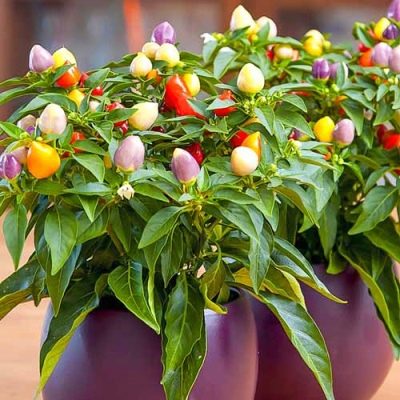
- Authors: Gavrish S.F., Dymnich O.V., Rak A.V.
- Year of approval: 1998
- Bush height, cm: 20-30
- Growth type: undersized
- Fruit shape: conical
- Fruit weight, g: 10
- Fruit color: in technical ripeness purple, in biological ripeness dark red
- Ripening terms: mid-early
- Ripening month: July, August, September, October
- Yield: high
The Queen of Spades is an ornamental variety of bell pepper, bred by Russian specialists and approved for use in 1998. Over the years, the variety has won an army of fans among gardeners. Let's figure out what are the features of the Queen of Spades.
Description of the variety
It is a shrub variety that can be used as a window sill crop. Despite the decorative properties, the plant bears fruit well for 5-6 years, and its fruits can be eaten. However, when growing peppers in your home or on your balcony, keep in mind that this is a very pungent variety, so cultivate it with extreme caution if there are children and animals in the house.
Characteristics of the appearance of plants and fruits
This is a low-growing plant, reaching a height of 20-30 cm. The bush develops round, miniature, has dark green lanceolate leaves, as well as small cone-shaped fruits. The peppers are dark red, with a smooth glossy skin and thin walls.
Purpose and taste
Fans of savory dishes can eat the Queen of Spades peppers fresh, but, as a rule, this vegetable is usually used for making spices and marinades. For example, you can dry it and then grind it for a delicious, aromatic seasoning for meat dishes. You can also make a hot sauce from this pepper. It is also suitable for canning.
Ripening terms
The first fruits can be removed already 85-90 days after germination, which is typical for varieties with a medium early ripening period. Fruiting is possible in July, August, September, October.
Yield
The variety is considered high-yielding, the bush brings up to 200 grams of miniature peppers per season. If the vegetable is grown at home, then there are usually two periods of fruiting.
Landing scheme
Sowing is carried out in late February - early March. Transplanting seedlings into open ground or a greenhouse is carried out at the end of May. Before sowing, it is advisable to process the planting material in a solution of a growth stimulator for 3-5 hours. Seeds can be scattered in a chaotic manner, then the container is covered with foil and removed to a bright place. The germination period depends on the age of the seeds, sometimes it reaches 15-20 days.
The sprouted shoots are periodically ventilated, moistened, and also dived at the two-leaf stage. Each bush is planted in a separate volumetric container, and then pinched, and then the plant will give all its strength in growth in width, and not in height.
When transplanting peppers into open ground, it is important to follow the 30x30 cm scheme.Choose an area for growing that is in the sun or in partial shade. It is very good if cucumbers, cabbage or legumes have previously grown on this bed.

To get a large and tasty harvest of pepper, you need to take care of the seedlings in advance. When growing pepper seedlings, you need to correctly determine the sowing time, pre-sowing seed treatment, prepare the necessary container and soil.
Growing and care
Water the planted peppers regularly, but in moderation. Overflows can provoke the spread of rot, and this will lead to the death of the plant.If the vegetable is grown in an apartment, then take care of good lighting - even one day of "lack of light" threatens to drop the fruit.
Well the bushes of the Queen of Spades respond to feeding. For example, for active fruit setting, it is recommended to use formulations containing phosphorus and potassium.
The plant is often used exclusively as an ornamental crop. For example, it can be grown as a perennial at home in a pot, and in summer it can be taken out into the garden and decorated with flower beds and flower beds. A picturesque landscape design can be created by placing bushes of the Queen of Spades variety next to chrysanthemums, asters, and small flowers.

To harvest a tasty and rich harvest of pepper, you need to comply with all the conditions of agricultural technology, and proper care begins with planting plants. Before planting pepper in open ground, it should be prepared. It is also important to take care of the seedlings and planting space in advance.




For good growth of pepper bushes and active fruiting, you need to regularly apply mineral and organic fertilizing to the soil. It is necessary not only to choose the right formulations, but also to use them at the right stage in the development of culture. The frequency of top dressing is always individual. It depends directly on the composition of the land on your site. The poorer the soil composition, the more often you will need to feed the pepper.

Pepper is one of the most common vegetables in home gardens. This culture is quite stable and unpretentious. However, under certain conditions, this plant can suffer from infections and harmful insects. Before treating peppers for diseases or pests, you need to find out the cause of the problem, otherwise the treatment may be ineffective.
Review overview
Despite the beauty of the Queen of Spades, as well as the possibility of eating it, many gardeners refuse to grow it due to the finickyness of the bushes. It is noted that the plant behaves capriciously with a lack of moisture, with untimely feeding or accidental shutdown of artificial lighting. However, those who are ready to cope with these difficulties decorate their plots with exquisite miniature bushes every year, and, in addition to a beautiful garden, receive a piquant spicy homemade seasoning.





















































































